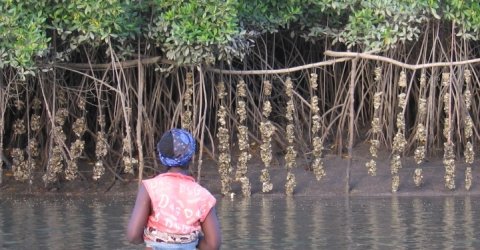
Recognising women's knowledge of traditional management of shellfish resources in the Bijagós Archipelago Ramsar Site
A recent project by the NGO Tiniguena has brought to light women's knowledge of traditional management of shellfish resources in the Bijagós Archipelago Ramsar Site. This project also sought to address the recent trend towards shellfish commercialisation by supporting community dialogue on amendments to traditional regulations that govern the exploitation of this valuable resource. Environmental education brochures for schools within the Ramsar Site were also developed and disseminated.
Guinea-Bissau designated the Archipel Bolama-Bijagós as a Ramsar Site in 2014. The archipelago, which is also a World Heritage Site and Biosphere Reserve, hosts one of the largest populations of migratory shorebirds in the world on its interidal mudflats (with over 870,000 recorded in 2001). It also hosts the largest colony of green turtles (Chelonia mydas) in Africa, and provides a habitat for over 15 vulnerable species including the West African Manatee (Trichechus senegalensis).
This exceptional archipelago is also a source of livelihoods for over 32,000 inhabitants who use some areas for rice farming, palm plantations and subsistence fishing, and others for cultural and spiritual purposes (https://rsis.ramsar.org/ris/2198).
The project undertaken by Tiniguena focused on women who collect shellfish and documented methods of traditional management, the role of shellfish in the Bijagó culture, its importance for food security and its economic potential.
The project also supported community dialogue on potential amendments to traditional regulations in order to address the recent trend towards commercialisation of shellfish resources. Representatives of the governance bodies of the AMPC (Área Marinha Pro- tegida Comunitária or Community Marine Protected Area) including the General Assembly, Youth Forum, and Women’s Forum, were approached to discuss possible amendments to traditional regulations, and to elaborate potential management measures. These management measures will be negotiated during the course of the Insular Assembly and the General Assembly of the AMPC, which is to take place in April 2018.
A brochure was also produced to support environmental education in schools within the Ramsar Site. This brochure provides information on the biology of the main shellfish species, their cultural and food security importance and their vulnerability to different pressures such as overexploitation and pollution, as well as recommendations for sustainable management of these valuable resources.
This project was made possible thanks to the generous support of the MAVA Foundation and Tiniguena in the context of the Ramsar Convention Secretariat project “Conservation of the natural and cultural heritage in wetlands: Global leadership for an integrated approach through the Ramsar Convention” (March 2015-March 2018), and in line with Decision SC53-15 of the Ramsar Standing Committee.